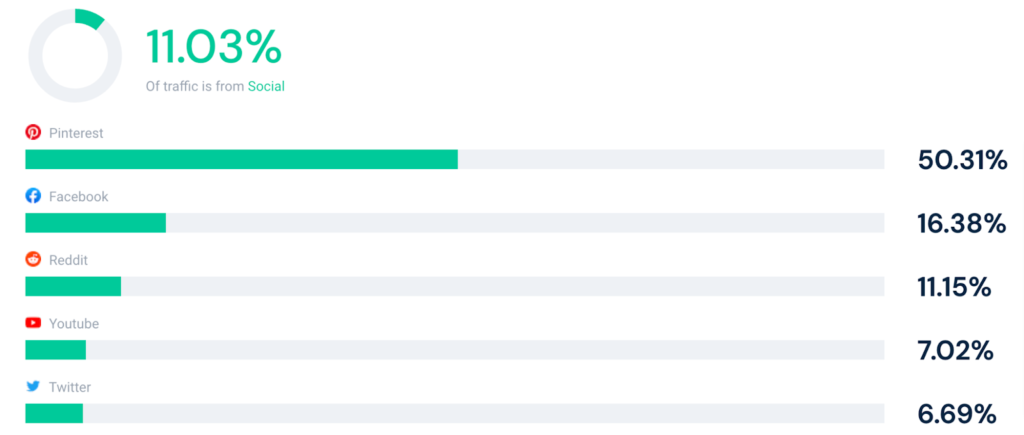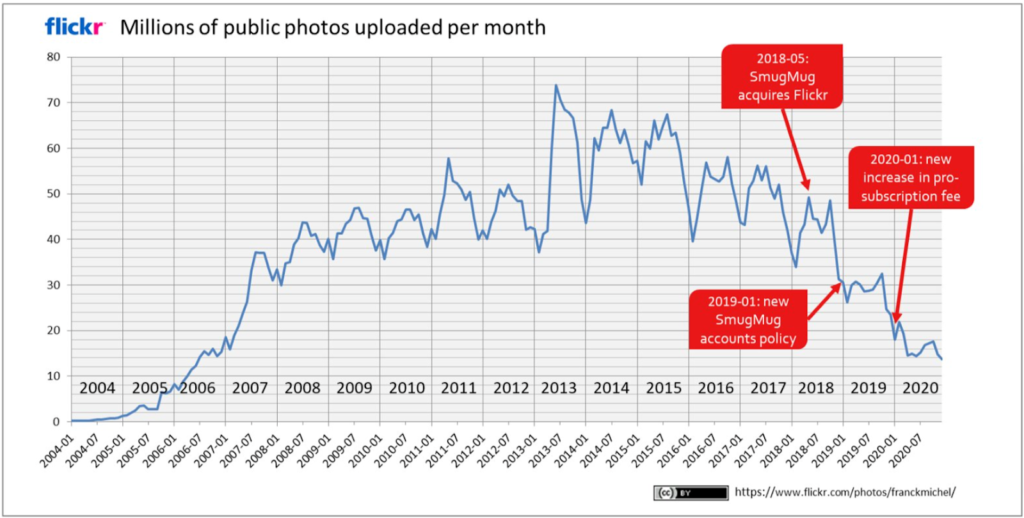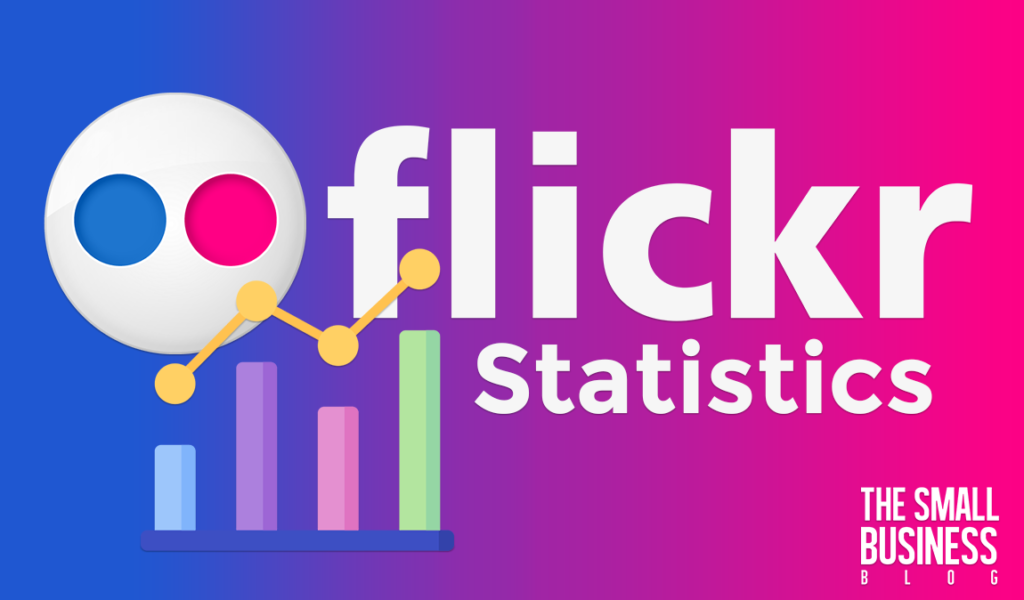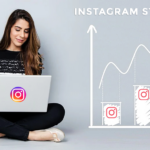Post Contents
- 1 Key Flickr Statistics
- 2 Top Flickr Statistics: In-Depth
- 3 A Short Timeline of Flickr
- 3.1 1. 100 Million Registered Photographers Use Flickr
- 3.2 2. 25 Million Photos Were Uploaded in A Day
- 3.3 3. People from 63 Countries Have Been Using Flickr
- 3.4 4. More than 10 Billion Images Shared on The Flickr Platform
- 3.5 5. 500 Million Photos in Flickr Has Creative Commons License
- 3.6 6. More than 3.5 Million Pictures Are Uploaded to Flickr Daily
- 3.7 7. 60 Million Users Are Actively Using Flickr Monthly
- 3.8 8. More than 7 Billion Api Requests Were Recorded in A Month
- 3.9 9. 63% of All the Photos Were Removed from Flickr
- 3.10 10. 11.03% of Traffic on Flickr Comes from Social Media
- 4 Conclusion
- 5 Sources
Key Flickr Statistics
- 100 million registered photographers use Flickr
- 25 million photos were uploaded in Flickr in a day
- People from 63 countries have been using Flickr
- More than 10 billion images shared on the Flickr platform
- 500 million photos in Flickr has Creative Commons License
- 3.5 million pictures are uploaded to Flickr daily
- 60 million users are actively using Flickr monthly
- More than 7 billion API requests were recorded in a month
- 29.82% of Flickr users are from the US
- 11.03% of traffic on Flickr comes from Social Media
Top Flickr Statistics: In-Depth
What are the various options that a photographer has when it comes to storing the original photos they took? It is easy to point out many options such as a physical storage device, online storage service providers, etc.
However, it is crucial to understand the classification between various facilities and their advantages. It is better to keep the original copies of the photos on a local device like a hard disk.
There are a lot of online image/video storage providers who offer different types of plans for storing pictures and videos, but nobody will assure 100% safety.
As we all know, anything can happen on storage facilities connected to the internet, and experts suggest keeping a local backup since original copies can be permanently lost if something happens unexpectedly.

Now, the next issue is the storage limit and portability. The images and videos can be enormous according to their quality. Also, people cannot carry the storage devices wherever they go.
The current smartphone cameras can click decent photographs and shoot videos compared to the camcorder, digital cameras, etc.
But since the smartphone’s physical storage is limited to a specific range, it is always better to depend upon online storage providers such as Google Drive/Photos, Microsoft OneDrive, Dropbox, and iCloud.
The advantages of using the before-mentioned platforms for people are many such as,
- No Concerns Related to The Physical Storage Limit of The Device.
- Precious Images and Videos Will Be Safe Even if The Smartphone or Physical Storage Device Is Lost or Damaged.
- Can Access the Digital Platforms from Any Place with Internet Support.
- Can Be Shared with Family and Friends According to The Requirement.
- Can Be Accessed from Multiple Devices.
- All Images and Videos Will Be Stored as Private.
But these platforms are not designed for showcasing your photography and video editing skills to the public.
Here comes the scope of Flickr. Flickr allows the user to upload photos and videos that people around the world can see.
The user can keep the images private even though that’s not the primary use of the application. Users can search their pictures inside the Flickr service and sometimes can be displayed on Google searches.
It also allows people to add links to the image and share the updates with them. So Flickr can be considered a platform where a user can upload pictures and videos to showcase skills and share them with the world.
Flickr allows the user to add posts without losing much quality and clarity(compared to Facebook, Twitter, etc.) and provides safety to the photographer’s contents(image copyright, theft, etc.).

A Short Timeline of Flickr
February 10, 2004 – Launched by Ludicorp of Stewart Butterfield and Caterina Fake
March 20, 2005 – Yahoo! acquired Ludicorp and Flickr
December 13, 2006 – upload limits on free accounts were increased to 100 MB a month which was 20 MB previously
2009 – Partnership with Getty Images so that the users can submit photos in return for payments.
June 13, 2017– Verizon Communications acquired Yahoo!
April 20, 2018 – SmugMug acquired Flickr from Verizon Communications
March 12, 2019 – Major accounts changes such as removing the 1TB storage facility from non-paid users came into being.
1. 100 Million Registered Photographers Use Flickr
Stewart Butterfield and Caterina Fake of Ludicorp were the founders of Flickr back in 2004. It has a basic user-free account setup in which people can upload content of 100MB size per month cost-free.
Flickr offers a monthly plan at $7.99/month, an annual plan at $5.99/month, and 3-Month Pro – Chargeable at $21.99 for three months.
2. 25 Million Photos Were Uploaded in A Day
Based on statistics, Flickr achieved the highest number of photos uploaded in a day in the first week of January 2017.
3. People from 63 Countries Have Been Using Flickr
The majority of users of Flickr are from the US. According to the statistics, 29.82% of users in Flickr come from the US, and 9.41% of users are from the UK.

4. More than 10 Billion Images Shared on The Flickr Platform
Despite the decrease in the popularity of the Flickr platform, it was still considered one of the most authentic platforms for showcasing professional creative content from the images and videos category.
5. 500 Million Photos in Flickr Has Creative Commons License
Flickr allows users to either release their images under specific standard usage licenses or label them as “all rights reserved.”
The licensing rights fundamentally include the Creative Commons 2.0 attribution-based and minor content-control licenses.
However, people cannot select the jurisdiction and version-specific licenses. The website allows easy searching of those images that fall under a special license.
6. More than 3.5 Million Pictures Are Uploaded to Flickr Daily
The social media and smartphone era have affected Flickr’s growth to a great extent. At one point, it provided 1TB storage space for its Free users, which was a shock to the global market.
The idea was to increase the application’s popularity, but later in 2019, SmugMug has canceled many features, including the 1TB storage.

7. 60 Million Users Are Actively Using Flickr Monthly
Yahoo purchased Ludicorp and Flickr on March 20, 2005. In 2007, Yahoo announced that its image storage service “Yahoo! Photos” would be removed, and they would delete all images on the platform.
It helped Flickr to gain more users. At that time, Flickr got prominent by the Yahoo acquisition, and the users count increased from 25000 to 2 million.
8. More than 7 Billion Api Requests Were Recorded in A Month
As per Flickr statistics from August 2009, Flickr is hosted on 62 databases across 124 servers that contain 8 lakh user accounts per pair of servers.
Flickr has been using the Geo microformat on over 3 million Geo-tagged images. The Flickr user can post pictures to their photostream through email attachments, enabling direct uploads from multiple streams.
Most of Flickr’s text-editing and tagging interfaces(like Organizer) use Ajax in their code to quickly load the website in most modern browsers.
9. 63% of All the Photos Were Removed from Flickr
After its acquisition by Smugmug, the photo-sharing platform introduced certain restrictions by which the free users were forced to delete images with more than 1,000 photos.
Smugmug requested the free users to remove all the other pictures/videos before January 8, 2019.
Flickr announced that from February 5, 2019, free account holders could not upload contents more than 1000 images/videos, and they will remove the existing supplementary contents until the count becomes 1000.

10. 11.03% of Traffic on Flickr Comes from Social Media
Even though social media has become the reason for the decline of Flickr users, it is interesting that the stats say 11.03% of its traffic is generated through various social media platforms. 50.31% among them are from Pinterest and 16.38% from Facebook.


As a result of the new 10$ increase in pro subscriptions price in January, Flickr has lost many of its Pro subscribers.
An active Pro Flickr user who was a former employee at Yahoo! commented that he no longer sees any scope for paying $63 per year to maintain a Flickr account.
He mentioned that the social media platforms like Facebook, Twitter, and Instagram offer more audiences for his photos free of charge.
Conclusion
The introduction, development, and current statistics of Flickr are a great business lesson for many growing enterprises.
Plenty of businesses, even with huge investments, failed in the first stage of their growth period, but Flickr was successful in its early years.
We can see that Yahoo! couldn’t adapt to the market changes in the period of 2010-2016, in which the world saw massive growth in technologies, the introduction of other photo and video platforms, the reign of smartphones, etc.
Based on the statistics shared in this post, it is clear that Flickr failed to come up with changes that could have raised its growth.
Also, the company’s decisions taken in the past 6-7 years(like free 1TB of storage for free users) upset its premium users.
Some premium users left the platform seeing a vast audience in social media platforms like Instagram, Facebook, and Twitter (free of cost).
The destruction of Flickr started from Yahoo! acquisition, and they are still breathing due to SmugMug! We can see that Yahoo! or later Verizon hasn’t invested enough money or talent to create a working business model for Flickr to prosper.
However, there are still passionate photographers actively contributing to Flickr, and they hope that the table will be theirs one day!































1 thought on “Flickr Statistics 2024: How Many People Use Flickr?”
I think flickr is a wonderful photo sharing site and am prepared to pay a subscription because it is so much better than others. I can, for example, post full resolution images, rather than low resolution compressed versions, as is the case with instagram and others.
I supose people expect things for free these days which will may make flickrs survival less likely. But I just love it. stevedexteruk flickr